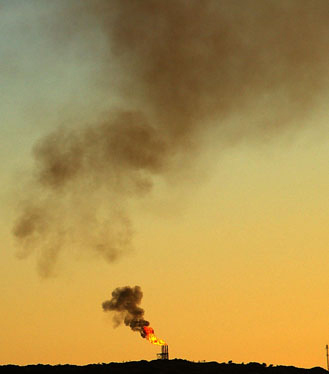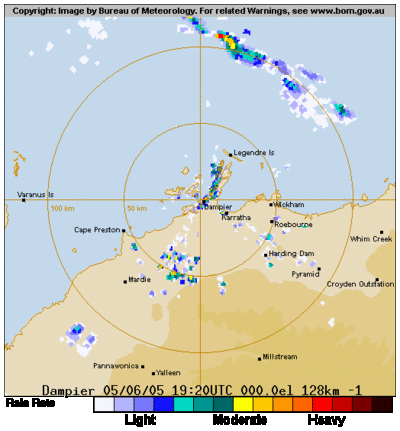Dampier carcinogens
 Emissions plume of Woodside at Dampier, on the morning of 5 June 2005, as seen from c. 20 km distance. Photo by Robin Chapple.
Radar ‘rain’ at Dampier on 5 June 2005. There was in fact no rain at all on that day, this is a record purely of air pollution. (Copyright notice and acknowledgment: image by Bureau of Meteorology.)
|
The Dampier industrial complex has been the largest pollution source of Australia for many years. However, the magnitude of the emissions or their potential or real effects has never been discussed publicly, and there has never been an investigation into the incidence of pollution-caused health issues among long-term residents of Dampier and nearby Karratha. Before considering this matter it is relevant, for a comparison of scale, to review the current action of Geelong residents against the Shell refinery at Corio Bay, Victoria. That facility emits 30,000 kg of benzene, which it is claimed has caused many deaths from leukaemia. But in comparison to the size of the emissions at the Dampier Woodside plant, those at Geelong are almost insignificant.
Here are the Woodside emissions of hydrocarbons and selected other pollutants (2003/4):
Benzene: a recognised carcinogen that has been shown in clinical tests to cause Acute Myelogenous Leukaemia, Acute Lymphatic Leukaemia, Chronic Myelogenous Leukaemia, Chronic Lymphatic Leukaemia, Hodgkin’s Disease and Hairy Cell Leukaemia. Also recognised as a developmental and reproductive toxicant. Long-term exposure can affect normal blood production and can be harmful to the immune system. Benzene has been linked with birth defects in both animals and humans. Ranked as one of the most hazardous compounds (worst 10%) to ecosystems and human health. In the USA the use of benzene has been banned for many years.
Woodside’s emission of benzene is stated to be 880,000 kg/year (the highest in Australia), but is probably underreported and in reality higher than that, particularly as it has been reported at 1,100,000 kg/year previously, and production has since increased significantly. The true figure is likely to be between 1,500,000 and 2,000,000 kg/year in 2005.
Cyclohexane: can irritate the skin, eyes, nose and throat. Exposure can cause nausea, dizziness, lightheadedness and drowsiness. Unconsciousness and death may occur at high exposures.
Woodside claims to emit 920,000 kg/year (highest in Australia).
Ethylbenzene: a carcinogen that is also suspected to be a cardiovascular or blood toxicant, developmental toxicant, and an endocrine, gastrointestinal, kidney and reproductive toxicant, as well as a neurotoxicant.
Woodside claims to emit 310,000 kg/year (highest in Australia).
n-Hexane: long exposure leads to paralysis of the arms and legs, and in laboratory animal tests the liquid’s vapours led to nerve and lung damage.
Woodside claims to emit a staggering 2,200,000 kg/year (highest in Australia).
Toluene (methylbenzene): the solvent of model glues, the subject of much substance abuse.
Wooside claims to emit 1,500,000 kg/year (highest in Australia).
Xylenes: affect the brain. Exposure can cause headaches, lack of muscle coordination, dizziness, confusion, and changes in one’s sense of balance. Exposure of people to high levels of xylene for short periods can also cause irritation of the skin, eyes, nose, and throat; difficulty in breathing; problems with the lungs; delayed reaction time; memory difficulties; stomach discomfort; and possibly changes in the liver and kidneys. Can cause unconsciousness and even death.
Woodside’s declared emission of xylenes is 620,000 kg/year (highest in Australia).
Total volatile organic compounds: Woodside has declared that it emitted 36,000,000 kg/year (highest in Australia) in 2003-2004. This quantity is probably well below real levels.
Oxides of nitrogen: major contributor to the acidification of precipitation (‘acid rain’). Since it began operations over 20 years ago, Woodside has lied about its NOx emissions, claiming them to be 5600 t/year until we caught them on 26 March 2003. They now claim to emit 12,000,000 kg/year.
Carbon monoxide: A poisonous gas. Woodside’s declared emissions are 680,000 kg/year.
Carbon dioxide: the principal “greenhouse” gas. Woodside does not declare its emission of this gas, but it is believed to be in the order of 12,000,000,000 kg/year, the highest in Australia.
The Dampier Woodside plant is Australia’s largest pollution source of most of the significant hydrocarbon pollutants, all of which are damaging to human health. The Dampier pollution plume is so dense that it is detected by rain radar every day of the year, and registered as light to heavy rain (see image above). In terms of its visibility on radar, it is greater than the sum total of all other Australian pollution clouds detectable by radar.
To check this, simply visit the Dampier rain radar website on any day when it does not rain in the region.
We have collected these records for the past two years to study atmospheric dynamics of the pollution at Dampier.
